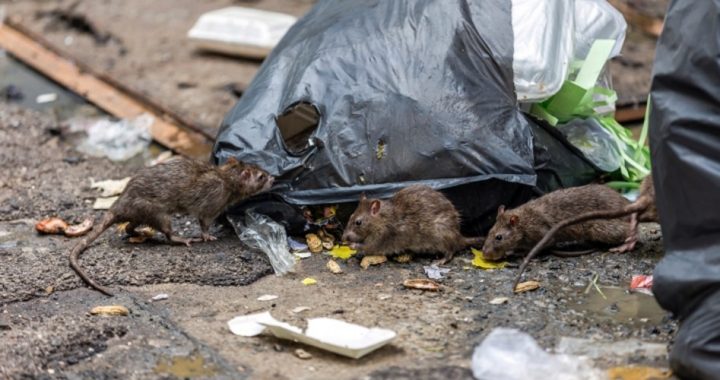
Podcast: Play in new window | Download ()
Subscribe: Android | RSS | More
In California, the rats that come with rampant filth and food-waste infused garbage are making an impressive comeback, as many large cities continue to fall into greater disrepair due to homelessness fueled by high real estate costs and illegal immigration. Now, environmentalists in the state are moving to take away a huge weapon in California’s war against the rats.
It’s not just Los Angeles and San Francisco, either. Those two hubs of homelessness are disgusting enough all on their own. But the State Capital in Sacramento is now in the throes of its own rat problem. Recently, the outdoor playground adjoining the Cal EPA building in downtown Sacramento had to be closed for fear that children playing there could be infected with rodent-borne diseases.
The building’s officials decided to set out powerful poison, as any normal organization would. You know, to kill the rats so they could allow their children to use the playground without worry. Unfortunately, the poison was not allowed to do its work because environmental activists accosted the state’s top environmental regulators and let them know that the poison they were using — although effective — was on a list of do-not-use substances. Cal EPA, good leftists that they are, backed down immediately.
“Effective immediately, I’m putting a moratorium on the use of rodenticides around the 1001 I Street building,” Cal EPA agency undersecretary Serena McIlwain told staff in a June 19 email. “We will continue to monitor the situation daily and will work aggressively to find effective, less toxic alternatives.”
Beyond Cal EPA’s moratorium, California legislators are now looking to ban all anticoagulant rat poisons such as the one in question. Although very effective, environmentalists are concerned that they may also be killing rat predators such as mountain lions, foxes, coyotes, and birds of prey.
A bill put forward by Assemblyman Richard Bloom (D-Santa Monica) AB1788 is currently winding its way through the California legislature. The bill looks to expand on a 2014 ban on selling anticoagulant rodenticides to consumers and ban the use of them by professionals as well.
“The time to act is now, our wildlife can’t wait any longer,” Bloom said.
Lisa Owens-Viani, founder of the group Raptors Are the Solution or RATS (get it?) is a leading lobbyist for the bill. “California’s wildlife are in grave peril right now,” Owens-Viani said.
You know who else is in “grave peril?” California residents who are dealing with diseases such as Typhus (167 cases in Los Angeles in 2018), Hantavirus (two deaths reported in California in 2018) and maybe even Bubonic Plague, which has not yet been reported but typically follows rat infestations.
Elizabeth Greenwood, a Los Angeles city attorney, is one victim of California’s rat infestation. Greenwood believes that she caught Typhus last year from fleas that were on rats attracted to the giant piles of trash that surrounded City Hall last year.
Before doctors figured out what was wrong with her, Greenwood spent several weeks at home, tormented by terrible headaches and weakness so severe that she could barely get out of bed. “This was the worst illness I’ve ever had,” Greenwood recalled. “I could actually die from this. This is how bad I feel.”
Greenwood has a message for the environmentalists so concerned the use of rodenticides: “If their child came home with this illness, I would imagine that most …very staunch environmentalists would actually pause before they were quite so vehement [about banning rodenticides]. Because it’s really bad. It really does kill people.”
Fortunately, AB1788 has exceptions for “public health crises.” But potential “public health crises” do not fall into that exception. For instance, the Typhus outbreak in Los Angeles could reasonably be called a public health crisis because cases of the disease were reported. The situation on the playground at Cal EPA’s office could not be, since no illness was reported in connection with that rat infestation.
So, in order to use the rodenticide that works, children would have to get sick first.
Environmentalists typically care more for wildlife (probably even the rats) than they do for human beings. A solution currently exists for dealing with California’s rat problem. But leftist politicians in the state won’t allow that solution to be used owing to possible side effects on the wildlife of the state.
Back in 1962, environmentalist Rachel Carson penned the book Silent Spring. In it, Carson vilified the use of DDT, a colorless, tasteless pesticide developed to free people from mosquitoes, fleas, and other disease-carrying insects. Carson’s book made the point that DDT was dangerous and potentially carcinogenic. The book was so successful in vilifying the chemical that its use was banned in most of the world.
But Carson only looked at the potential risks associated with DDT (which have been disputed), not its benefits. And its benefits were many.
It’s been estimated that millions of people have needlessly died from malaria and other insect-borne diseases since Carson’s book of environmental propaganda was released. How many will die in California because of this short-sighted environmentalist nonsense?
Image: Chanawat Phadwichit via iStock / Getty Images Plus



